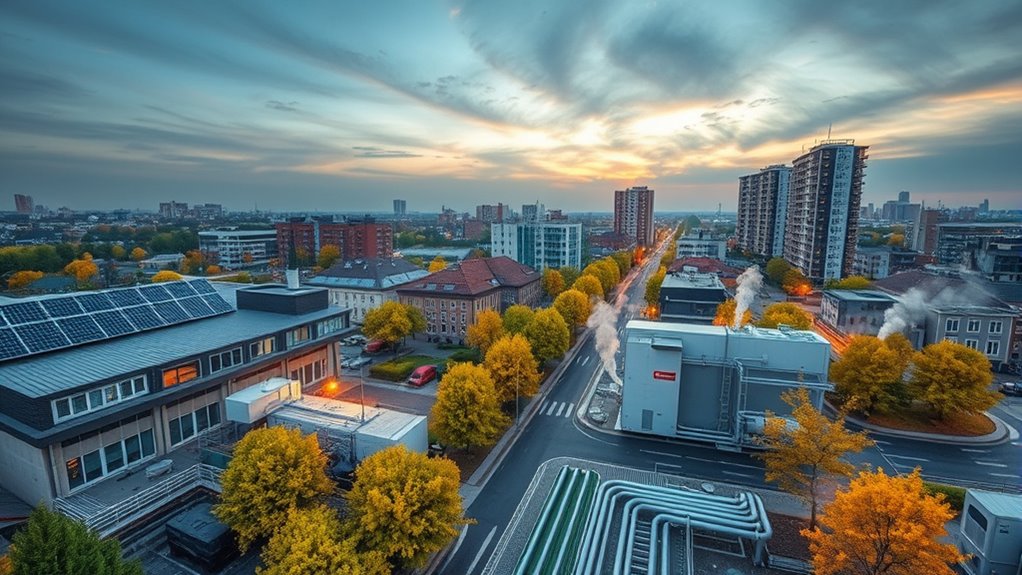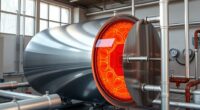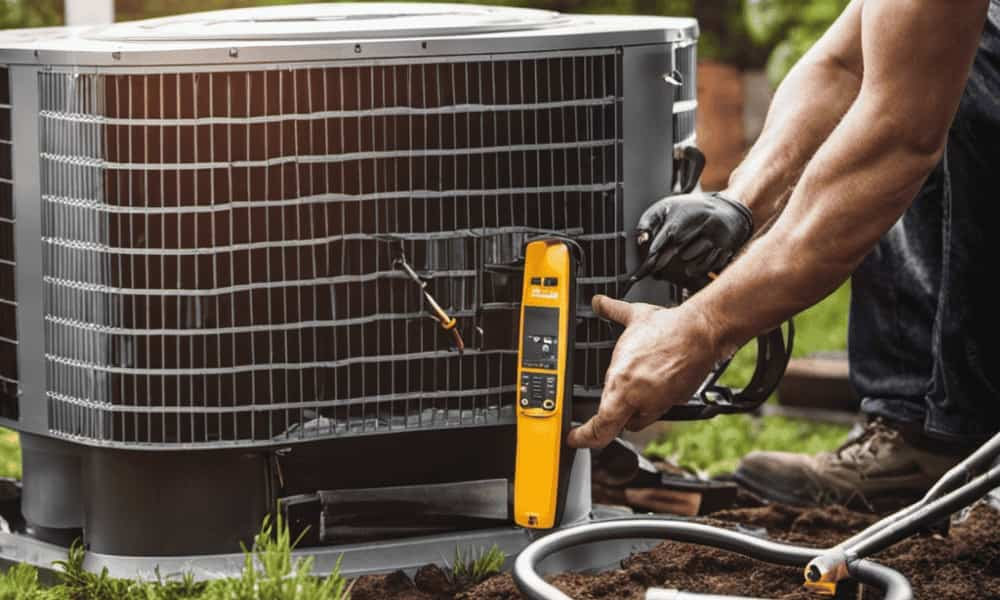District heating networks powered by heat pumps and renewables offer a sustainable way to heat urban areas efficiently. By transferring heat from the environment and integrating solar, wind, or geothermal sources, these systems cut reliance on fossil fuels and lower emissions. Heat pumps, combined with advanced control tech and thermal storage, optimize energy use and resilience. Exploring these innovations reveals how cities worldwide are transforming their energy future—keep going to find out more.
Key Takeaways
- Heat pumps transfer environmental heat to buildings, reducing reliance on fossil fuels and supporting sustainable district heating systems.
- Integrating renewables like solar, wind, and geothermal enhances the sustainability and efficiency of district heating networks.
- Thermal storage and smart controls optimize renewable energy use and balance supply and demand in heat pump-powered systems.
- Infrastructure development, including underground pipelines and renewable energy hubs, facilitates efficient heat transfer and system expansion.
- Successful global examples demonstrate reduced emissions, increased energy resilience, and long-term cost savings through renewable-powered district heating.
The Role of Heat Pumps in Modern District Heating
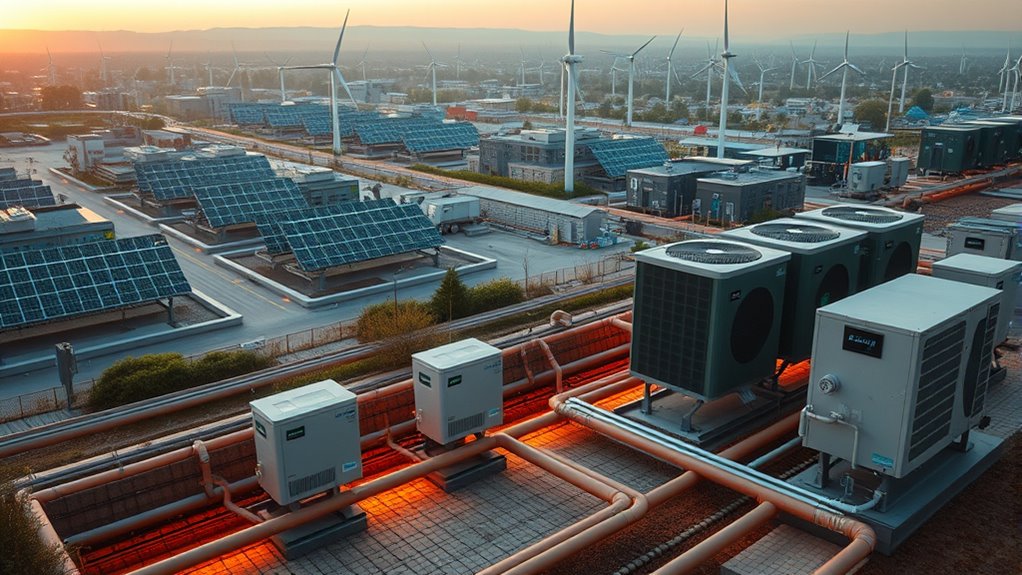
Have you ever wondered how modern district heating systems stay efficient and environmentally friendly? Heat pumps play a crucial role by transferring heat from the environment into buildings, reducing reliance on fossil fuels. The key to their effectiveness lies in heat pump efficiency, which depends on optimized operation and proper sizing. Using advanced refrigerant types, like R-32 or R-134a, helps improve performance and lower environmental impact, as these refrigerants have lower global warming potentials. Selecting the right refrigerant is essential for maximizing efficiency and minimizing leaks. Modern heat pumps are designed to operate efficiently across varying conditions, making them ideal for district heating networks. Their ability to harness ambient heat while maintaining high efficiency makes them indispensable for sustainable urban energy solutions. Additionally, integrating lifestyle considerations, such as smart controls and user-friendly interfaces, can enhance the overall effectiveness of heat pump systems in district networks.
Integrating Renewable Energy Sources Into Urban Heating Systems

Integrating renewable energy sources into urban heating systems offers a viable path toward reducing carbon emissions and enhancing energy resilience. By leveraging local solar, wind, and geothermal resources, you can create a more sustainable district heating network. Effective thermal storage plays a pivotal role, allowing you to store excess renewable energy for later use, smoothing out supply fluctuations. Proper district zoning is essential, helping you optimize infrastructure placement and manage energy flows efficiently. Consider these key strategies:
Harness local renewable sources and thermal storage to optimize urban heating and reduce emissions effectively.
- Deploy thermal storage to balance intermittent renewable sources
- Adjust district zoning to maximize renewable resource access
- Incorporate smart controls for seamless energy integration
- Monitor and track energy usage and storage to optimize system performance tracking thermal storage and energy use
Together, these approaches enable a cleaner, more reliable urban heating system that harnesses renewable energy’s full potential.
Advantages of Using Heat Pumps for District Heating
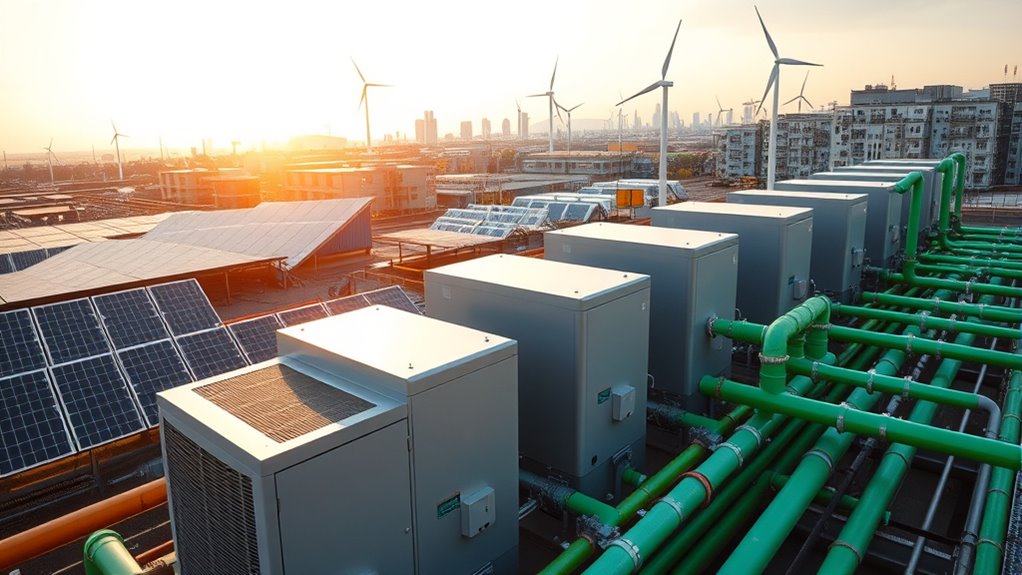
Using heat pumps in district heating can considerably boost energy efficiency, helping you reduce overall energy consumption. They also lower emissions, making your system more environmentally friendly. These advantages make heat pumps a smart choice for sustainable urban heating. Incorporating renewable energy sources like solar or wind can further enhance the sustainability of district heating networks powered by heat pumps.
Energy Efficiency Benefits
Are heat pumps a game-changer for district heating efficiency? Absolutely. They considerably reduce energy consumption by extracting heat from the environment, making systems more sustainable and cost-effective. With thermal storage, you can store excess heat for later use, optimizing energy use during peak times. Heat pumps also enable district cooling, providing a versatile solution for climate control needs while increasing overall efficiency. Additionally, their high coefficient of performance (COP) means less energy is needed to deliver the same heating output. This results in lower operational costs and reduced emissions. Incorporating heat pumps into district heating networks maximizes energy utilization, simplifies integration with renewable sources, and enhances the overall sustainability of your heating infrastructure. Modern heat pumps are designed with noise reduction technology, ensuring quieter operation that does not disturb residents or businesses.
Lower Emission Impact
Heat pumps substantially lower emissions in district heating systems by replacing fossil fuel-based energy sources with cleaner, renewable options. This shift reduces greenhouse gases and air pollutants, contributing to a healthier environment. Additionally, heat pumps support district cooling, which can decrease the need for energy-intensive cooling methods, further cutting emissions. Incorporating thermal storage allows you to store excess renewable energy, optimizing heat pump operation and reducing the reliance on fossil fuels during peak demand. This flexibility enhances system efficiency and lowers overall carbon footprint. Creativity in problem-solving can be applied to optimize the integration of heat pumps with thermal storage and district cooling, creating a more sustainable, low-emission district heating network that aligns with climate goals while maintaining reliable energy supply.
Key Technologies Driving Sustainable Heating Networks

You’ll see that advances in heat pump technology make heating more efficient and environmentally friendly. Integrating renewable energy sources further reduces carbon emissions, creating a more sustainable network. Smart management systems optimize operations, ensuring reliability and cost savings across the entire system. Additionally, implementing tuning techniques in heat pump systems can enhance performance and adaptability to varying energy demands.
Heat Pump Technology Advances
Advancements in heat pump technology are transforming sustainable heating networks by making them more efficient and adaptable. Innovations like geothermal innovation have improved how heat pumps extract energy from the earth, increasing efficiency in various climates. New heat pump materials enhance durability and performance, reducing maintenance costs and extending lifespan. These developments allow for higher coefficients of performance (COP) and lower energy consumption. To keep you engaged, consider these key breakthroughs:
- Enhanced geothermal innovation improves heat extraction efficiency
- Advanced heat pump materials boost durability and lifespan
- Technological improvements enable lower operating costs and better performance
- Incorporating renewable energy sources further enhances the sustainability of district heating systems.
These advances make heat pumps more viable for large-scale district heating, supporting the shift toward renewable and sustainable energy solutions.
Renewable Energy Integration
How can renewable energy sources be seamlessly integrated into district heating networks? You can achieve this by utilizing geothermal loops, which tap into the earth’s stable temperature to provide reliable heat. Geothermal energy offers a consistent renewable source that reduces reliance on fossil fuels. Additionally, solar thermal systems capture sunlight to produce hot water, supplementing other heat sources during peak sunlight hours. Combining these technologies allows you to optimize energy use and increase the share of renewables in your network. Proper integration involves designing systems that adapt to varying energy availability, ensuring efficient heat distribution. By leveraging geothermal loops and solar thermal, you create a sustainable, resilient network that minimizes emissions and supports long-term energy goals. Incorporating vetted product reviews can help identify the most reliable equipment for these renewable solutions.
Smart Network Management
Integrating renewable energy sources into district heating networks requires sophisticated management to optimize their variable outputs. Smart network management systems adapt in real-time, balancing heat production with demand and maximizing efficiency. Key technologies include advanced control algorithms, predictive analytics, and IoT sensors. These tools enable you to:
- Optimize thermal storage, ensuring excess heat is stored for later use
- Coordinate district cooling and heating, improving overall system flexibility
- Maintain stable supply despite fluctuations in renewable generation
- Incorporate celebrity lifestyle insights to inspire innovative design and operation strategies that enhance system sustainability
Case Studies of Successful Implementation Worldwide
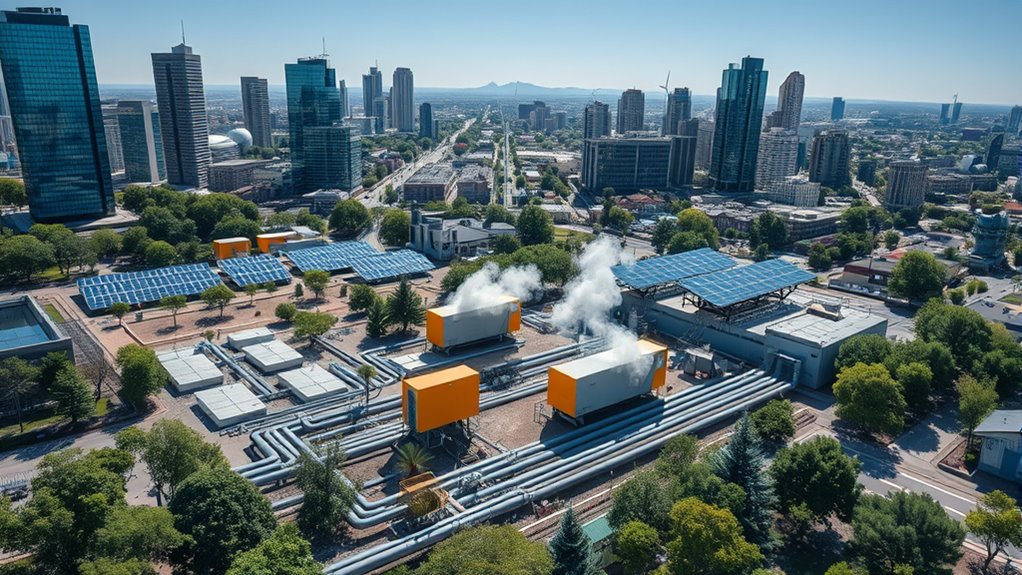
Across the globe, several cities have successfully implemented district heating networks that demonstrate their practicality and benefits. In Copenhagen, they integrated renewable energy sources like wind and biomass into their district heating system, markedly reducing fossil fuel reliance. Stockholm’s district heating network combines waste heat recovery with renewable integration, cutting emissions and boosting efficiency. In Helsinki, the city expanded its district heating using heat pumps powered by renewables, ensuring a sustainable supply even during cold winters. These examples show that modern district heating can effectively incorporate renewable sources, lowering carbon footprints and enhancing energy resilience. By learning from these successful implementations, you can see how combining district heating with renewable energy is both feasible and advantageous worldwide.
Challenges and Solutions in Deploying Renewable-Powered District Heating
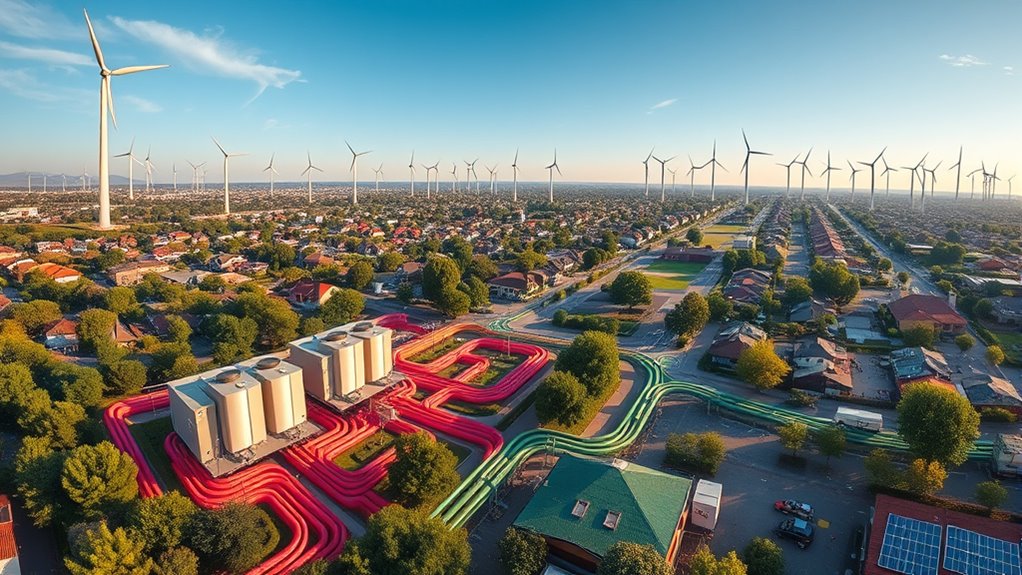
Implementing renewable-powered district heating faces several significant challenges, from technical limitations to economic hurdles. One major renewable challenge is integrating variable energy sources like solar and wind into existing systems. Additionally, upgrading infrastructure to handle renewable heat can be costly and complex. You also face the issue of ensuring consistent supply during peak demand periods. To overcome these hurdles, consider solutions such as:
- Investing in thermal energy storage to balance supply and demand
- Enhancing grid flexibility with smart control systems
- Developing hybrid systems combining renewables with traditional heat sources
- Promoting organic seed cultivation methods to support sustainable resource management, which can indirectly benefit renewable energy initiatives by fostering environmentally friendly practices.
Addressing these renewable challenges requires innovative approaches, strategic planning, and investment. While obstacles exist, implementing effective solutions can make renewable-powered district heating a viable, sustainable option for communities.
Policy and Incentives Supporting Green Heating Initiatives
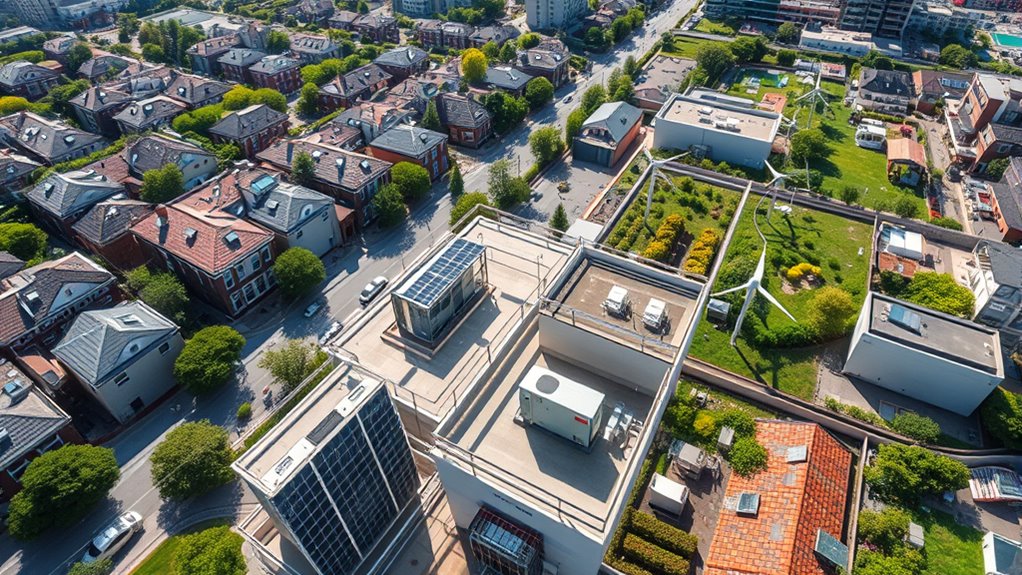
What policies and incentives are driving the shift toward green heating solutions? Policy frameworks play a crucial role by setting clear targets for renewable energy adoption, encouraging investments in district heating networks powered by heat pumps. Governments worldwide are implementing financial incentives like grants, tax credits, and subsidies to lower upfront costs for renewable heating projects. These incentives make it easier for you to adopt sustainable systems and accelerate transition efforts. Additionally, regulations may require utilities to meet renewable energy quotas, further supporting green initiatives. By aligning policy frameworks with financial incentives, authorities create a conducive environment for deploying renewable-powered district heating. This combination motivates stakeholders, from developers to consumers, to prioritize clean heating options and helps build a resilient, sustainable energy future.
Economic Benefits of Transitioning to Renewable Heat Networks
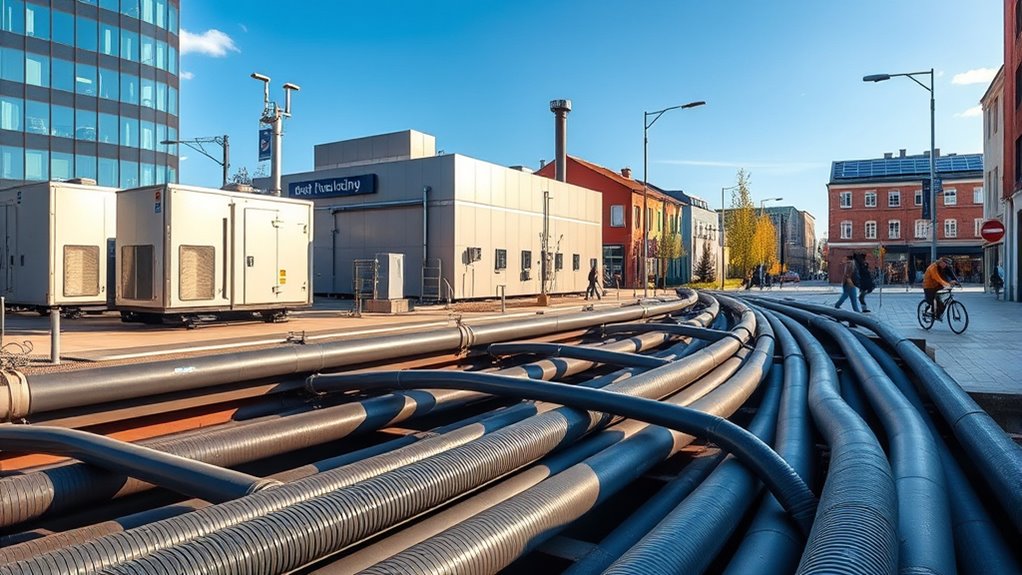
Switching to renewable heat networks can considerably cut your energy costs over time, offering long-term savings. Additionally, this transition can create new job opportunities in installation, maintenance, and manufacturing sectors. Exploring these economic benefits helps you understand how sustainable heating can boost both your finances and local employment.
Cost Savings Potential
Have you considered how shifting to renewable heat networks can markedly cut your long-term costs? Moving to these systems offers significant cost reduction and better budget optimization. By investing in heat pumps and renewable sources, you can lower energy expenses over time.
Key benefits include:
- Reduced operational costs due to higher efficiency and renewable energy sources
- Lower maintenance expenses with durable, modern equipment
- Stable energy prices, minimizing budget fluctuations
These savings not only improve your financial health but also make your heating infrastructure more resilient. Over the long run, the initial investment pays off through decreased energy bills and fewer unexpected costs. Embracing renewable heat networks helps you maximize economic benefits while contributing to sustainability goals.
Job Creation Opportunities
Shifting to renewable heat networks creates a surge of job opportunities across design, installation, and maintenance sectors. As district heating systems transition to incorporate heat pumps and renewable sources, demand rises for skilled workers in planning and engineering. You’ll find new roles in developing efficient district heating layouts, installing advanced heat pump technology, and maintaining these systems to guarantee optimal performance. This transition not only boosts local economies but also fosters innovation within the renewable energy sector. Job growth extends to manufacturing components, system integration, and ongoing technical support. By embracing renewable heat networks, you contribute to a sustainable future while opening pathways for employment in clean energy industries. These opportunities benefit communities and strengthen the workforce aligned with the shift to greener, more efficient district heating solutions.
Future Trends in Heat Pump and Renewable Integration
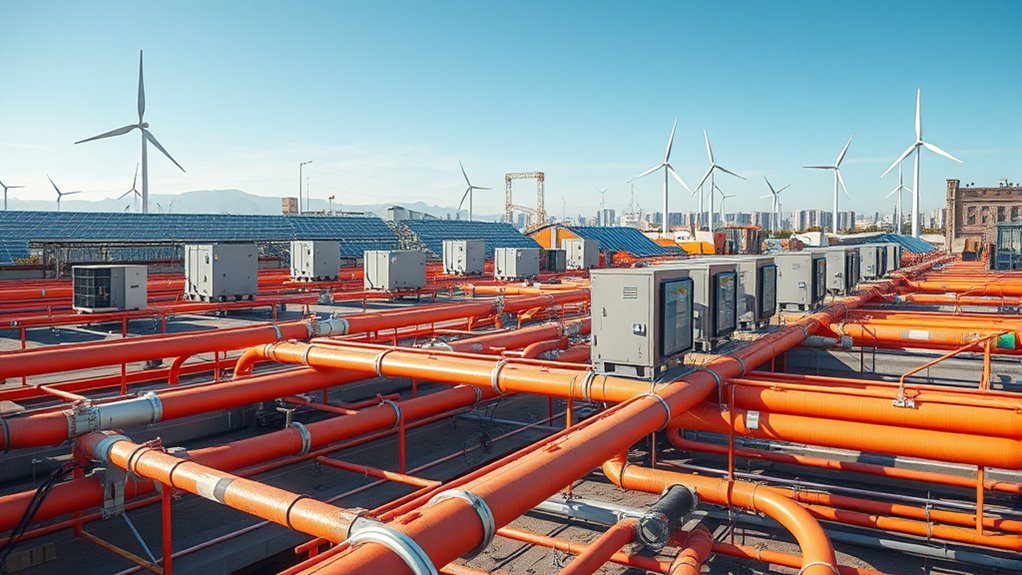
As the demand for sustainable energy solutions grows, innovations in heat pump technology and renewable integration are shaping the future of district heating networks. You’ll see smarter systems that optimize energy use, support urban cooling, and improve building insulation. These advances allow for more efficient heat pump performance and seamless renewable energy use. Future trends include:
- Integration with smart grids for real-time energy management
- Enhanced urban cooling capabilities to combat heat islands
- Use of advanced building insulation to reduce overall energy demand
These developments mean you’ll benefit from more reliable, eco-friendly heating while supporting climate goals. As technology evolves, district heating will become even more adaptable, contributing to greener, more sustainable cities.
Strategies for Urban Planning and Infrastructure Development
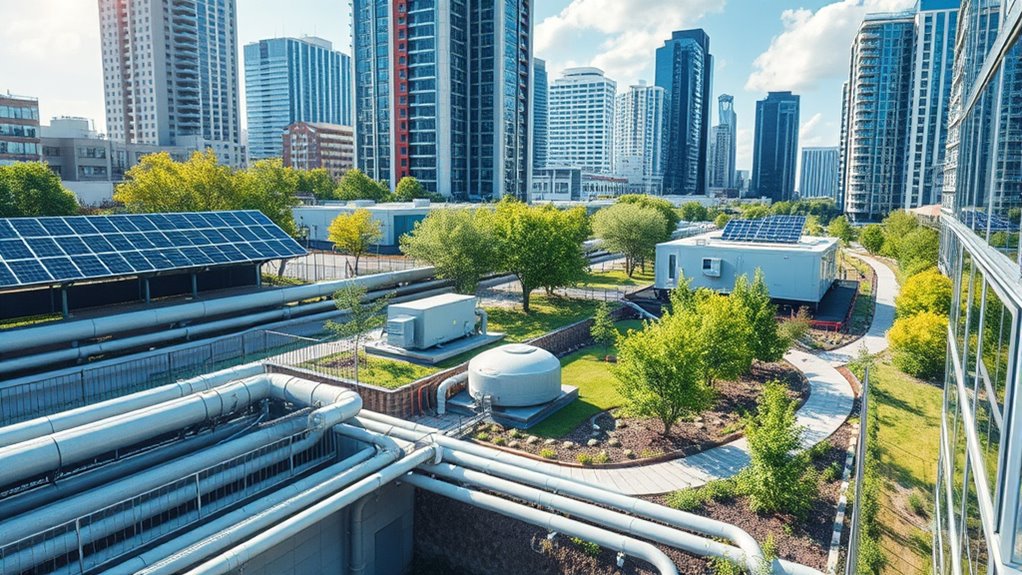
Effective urban planning and infrastructure development are essential for integrating district heating networks into modern cities. You should prioritize urban greening, which enhances energy efficiency and reduces cooling demands, creating a healthier environment. Incorporate transportation planning to optimize traffic flow and reduce emissions, making way for infrastructure that supports heat pump systems and renewable sources. Design city layouts that facilitate the installation of underground pipelines and renewable energy hubs, ensuring easy access and maintenance. Encourage mixed-use developments to shorten distribution distances and improve energy distribution. Incorporate green corridors and parks to support sustainable urban environments. Prioritizing these strategies helps you develop resilient, energy-efficient cities where district heating networks powered by renewables seamlessly integrate into daily life.
Frequently Asked Questions
How Do Heat Pumps Operate Efficiently in Varying Climate Conditions?
You might wonder how heat pumps stay efficient in different climates. Their efficiency depends on climate adaptability; in milder weather, they work more effectively, while in colder conditions, modern heat pumps use advanced refrigerants and defrosting technology to maintain performance. By selecting the right type and ensuring proper installation, you can optimize heat pump efficiency across various climates, making them a reliable and energy-efficient choice year-round.
What Are the Environmental Impacts of Large-Scale Renewable District Heating?
They say a chain is only as strong as its weakest link. Large-scale renewable district heating reduces your carbon footprint and lessens resource depletion by utilizing sustainable sources like wind and solar. However, it can also influence land use and ecosystems. While it’s a cleaner alternative, you should consider potential environmental trade-offs, such as habitat disruption, to ensure you’re truly supporting a greener future.
How Can Existing Infrastructure Be Adapted for Renewable Heat Sources?
You can adapt existing district infrastructure for renewable heat sources by evaluating current systems and identifying retrofit challenges. Upgrades may include installing heat pumps or integrating renewable energy sources like solar or biomass. You’ll need to modify pipelines and control systems, ensuring compatibility with renewable inputs. Although retrofit challenges exist, strategic planning and phased implementation make it possible to shift smoothly, maximizing efficiency and sustainability without entirely replacing your infrastructure.
What Are the Long-Term Maintenance Costs of Renewable-Powered Heating Networks?
Considering the current question, you should focus on cost estimation and maintenance planning for renewable-powered heating networks. Long-term maintenance costs tend to be lower due to fewer moving parts and cleaner operations, but initial investments can be substantial. You’ll want to monitor system performance, predict potential repairs, and plan for periodic upkeep to keep costs managed. Proper planning ensures your network remains reliable, resilient, and cost-effective over the decades.
How Do Policy Changes Influence the Adoption Rate of Green Heating Systems?
Policy incentives and market dynamics markedly influence how quickly you adopt green heating systems. When policies favor renewable energy through subsidies or stricter emissions standards, you find it easier to justify investments. Conversely, market factors like technology costs and energy prices can either accelerate or hinder adoption. If policies remain consistent and supportive, you’re more likely to embrace sustainable options, making the shift smoother and more widespread.
Conclusion
Just as Da Vinci envisioned innovation blending art and science, embracing heat pumps and renewables transforms urban heating into a sustainable masterpiece. By integrating cutting-edge technologies and supportive policies, you can lead the charge toward a greener future. Remember, the torch of progress is in your hands—guiding your city toward cleaner, more efficient heating systems. Your choices today shape the sustainable landscapes of tomorrow, turning the Renaissance of green energy into your legacy.
